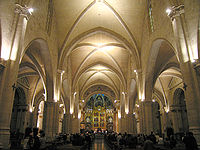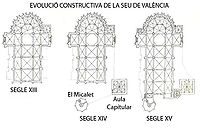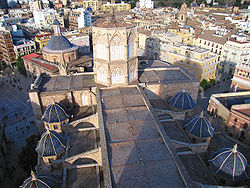
Saint Mary of Valencia Cathedral
Encyclopedia



Reconquista
The Reconquista was a period of almost 800 years in the Middle Ages during which several Christian kingdoms succeeded in retaking the Muslim-controlled areas of the Iberian Peninsula broadly known as Al-Andalus...
, Pere d'Albalat, Archbishop of Tarragona, and was dedicated by order of James I the Conqueror to Saint Mary
Blessed Virgin Mary (Roman Catholic)
Roman Catholic veneration of the Blessed Virgin Mary is based on Holy Scripture: In the fullness of time, God sent his son, born of a virgin. The mystery of the incarnation of the Son of God through Mary thus signifies her honour as Mother of God...
. It was built over the site of the former Visigothic cathedral, which under the Moors had been turned into a mosque
Mosque
A mosque is a place of worship for followers of Islam. The word is likely to have entered the English language through French , from Portuguese , from Spanish , and from Berber , ultimately originating in — . The Arabic word masjid literally means a place of prostration...
. Gothic architecture
Gothic architecture
Gothic architecture is a style of architecture that flourished during the high and late medieval period. It evolved from Romanesque architecture and was succeeded by Renaissance architecture....
, in its Catalan or Mediterranean version, is the predominant style of this cathedral, although it also contains Romanesque
Romanesque architecture
Romanesque architecture is an architectural style of Medieval Europe characterised by semi-circular arches. There is no consensus for the beginning date of the Romanesque architecture, with proposals ranging from the 6th to the 10th century. It developed in the 12th century into the Gothic style,...
, French Gothic
French Gothic architecture
French Gothic architecture is a style of architecture prevalent in France from 1140 until about 1500.-Sequence of Gothic styles: France:The designations of styles in French Gothic architecture are as follows:* Early Gothic* High Gothic...
, Renaissance, Baroque
Baroque architecture
Baroque architecture is a term used to describe the building style of the Baroque era, begun in late sixteenth century Italy, that took the Roman vocabulary of Renaissance architecture and used it in a new rhetorical and theatrical fashion, often to express the triumph of the Catholic Church and...
and Neo-Classical
Neoclassical architecture
Neoclassical architecture was an architectural style produced by the neoclassical movement that began in the mid-18th century, manifested both in its details as a reaction against the Rococo style of naturalistic ornament, and in its architectural formulas as an outgrowth of some classicizing...
elements.
One of the supposed Holy Chalice
Holy Chalice
In Christian tradition the Holy Chalice is the vessel which Jesus used at the Last Supper to serve the wine.The Gospel of Matthew says:...
s in the world is revered in one of this cathedral's chapels; this chalice has been defended as the true Holy Grail
Holy Grail
The Holy Grail is a sacred object figuring in literature and certain Christian traditions, most often identified with the dish, plate, or cup used by Jesus at the Last Supper and said to possess miraculous powers...
; indeed, most Christian historians all over the world declare that all their evidence points to this Valencian chalice as the most likely candidate for being the authentic cup used at the Last Supper
Last Supper
The Last Supper is the final meal that, according to Christian belief, Jesus shared with his Twelve Apostles in Jerusalem before his crucifixion. The Last Supper provides the scriptural basis for the Eucharist, also known as "communion" or "the Lord's Supper".The First Epistle to the Corinthians is...
. It was the official papal chalice for many pope
Pope
The Pope is the Bishop of Rome, a position that makes him the leader of the worldwide Catholic Church . In the Catholic Church, the Pope is regarded as the successor of Saint Peter, the Apostle...
s, and has been used by many others, most recently by Pope Benedict XVI
Pope Benedict XVI
Benedict XVI is the 265th and current Pope, by virtue of his office of Bishop of Rome, the Sovereign of the Vatican City State and the leader of the Catholic Church as well as the other 22 sui iuris Eastern Catholic Churches in full communion with the Holy See...
, on July 9, 2006. This chalice dates from the 1st century, and was given to the cathedral by king Alfonso V of Aragon
Alfonso V of Aragon
Alfonso the Magnanimous KG was the King of Aragon , Valencia , Majorca, Sardinia and Corsica , and Sicily and Count of Barcelona from 1416 and King of Naples from 1442 until his death...
in 1436.
The cathedral contains numerous 15th century paintings, some by local artists (such as Jacomart
Jacomart
Jaime Baço, also spalled Jaume Baco or Jacomart was a Spanish painter from Valencia.Most of his life is scarcely documented. He worked in his native city until 1442, when he was called to Naples by Alfonso V of Aragon. he had a deep influence on the local school, including artists such as...
), others by artists from Rome
Rome
Rome is the capital of Italy and the country's largest and most populated city and comune, with over 2.7 million residents in . The city is located in the central-western portion of the Italian Peninsula, on the Tiber River within the Lazio region of Italy.Rome's history spans two and a half...
engaged by the Valencian Pope Alexander VI
Pope Alexander VI
Pope Alexander VI , born Roderic Llançol i Borja was Pope from 1492 until his death on 18 August 1503. He is one of the most controversial of the Renaissance popes, and his Italianized surname—Borgia—became a byword for the debased standards of the Papacy of that era, most notoriously the Banquet...
who, when still a cardinal, made the request to elevate the Valencian See to the rank of metropolitan see, a category granted by Pope Innocent VIII in 1492.
History
Most of Valencia Cathedral was built between the 13th century and the 15th century, and thus its style is mainly GothicGothic architecture
Gothic architecture is a style of architecture that flourished during the high and late medieval period. It evolved from Romanesque architecture and was succeeded by Renaissance architecture....
. However, its construction went on for centuries. As a consequence there is a mixture of artistic styles, ranging from the early Romanesque
Romanesque architecture
Romanesque architecture is an architectural style of Medieval Europe characterised by semi-circular arches. There is no consensus for the beginning date of the Romanesque architecture, with proposals ranging from the 6th to the 10th century. It developed in the 12th century into the Gothic style,...
, Renaissance
Renaissance
The Renaissance was a cultural movement that spanned roughly the 14th to the 17th century, beginning in Italy in the Late Middle Ages and later spreading to the rest of Europe. The term is also used more loosely to refer to the historical era, but since the changes of the Renaissance were not...
, Baroque
Baroque
The Baroque is a period and the style that used exaggerated motion and clear, easily interpreted detail to produce drama, tension, exuberance, and grandeur in sculpture, painting, literature, dance, and music...
and Neoclassical
Neoclassical architecture
Neoclassical architecture was an architectural style produced by the neoclassical movement that began in the mid-18th century, manifested both in its details as a reaction against the Rococo style of naturalistic ornament, and in its architectural formulas as an outgrowth of some classicizing...
.
Excavations in the adjacent Almoina Archaeological Centre have unearthed the remains of the ancient Visigothic cathedral, which later became a mosque
Mosque
A mosque is a place of worship for followers of Islam. The word is likely to have entered the English language through French , from Portuguese , from Spanish , and from Berber , ultimately originating in — . The Arabic word masjid literally means a place of prostration...
. There is documentary evidence that some decades after the Christian conquest of the city (1238), the mosque-cathedral remained standing, even with the Koranic
Qur'an
The Quran , also transliterated Qur'an, Koran, Alcoran, Qur’ān, Coran, Kuran, and al-Qur’ān, is the central religious text of Islam, which Muslims consider the verbatim word of God . It is regarded widely as the finest piece of literature in the Arabic language...
inscriptions on the walls, until 22 June 1262, when the then bishop, Andreu d'Albalat resolved to knock it down and build a new cathedral in its place, according to the plans of the architect Arnau Vidal.
Stones from neighboring quarries in Burjassot
Burjassot
Burjassot is a municipality in the comarca of Horta Nord in the Valencian Community, Spain. The footballer José Carlos Cerveró was born there on 11th December 1979....
and Godella
Godella
Godella is a municipality in the comarca of Horta Nord, province of Valencia, Spain.Godella was founded in 1238 by the cession of James I of Aragon of a region named Godayla to the Aragonese Pedro Maza....
were used to build the cathedral, but also from other more distant quarries such as those in Benidorm
Benidorm
Benidorm is a coastal town and municipality located in the comarca of Marina Baixa, in the province of Alicante, Valencian community, Spain, by the Western Mediterranean....
and Xàbia
Xàbia
Xàbia is a coastal town located in the comarca of Marina Alta, in the province of Alicante, Spain, by the Mediterranean Sea. Situated behind a wide bay and sheltered between two rocky headlands, the town has become a very popular small seaside resort and market town.-Geography:Xàbia is situated in...
, which came by boat.
Some reasons for the simplicity and sobriety of Valencia Cathedral are that it was built quickly to mark the Christian territory against the Muslims, and that it was not a work by a king, but by the local bourgeoisie.
Construction
Although there are several styles of construction, this cathedral is basically a Gothic building, a cruciform plan with transepts north and south, and a crossing covered by an octagonal tower (cimbori), with an ambulatoryAmbulatory
The ambulatory is the covered passage around a cloister. The term is sometimes applied to the procession way around the east end of a cathedral or large church and behind the high altar....
and a polygonal apse
Apse
In architecture, the apse is a semicircular recess covered with a hemispherical vault or semi-dome...
.
This cathedral was began at the end of the 13th century (1270–1300) at the same time as the mosque
Mosque
A mosque is a place of worship for followers of Islam. The word is likely to have entered the English language through French , from Portuguese , from Spanish , and from Berber , ultimately originating in — . The Arabic word masjid literally means a place of prostration...
was being demolished. The first part to be finished was the ambulatory with its eight radiating chapels, and the Almoina Romanesque gate.


The old chapter house
Chapter house
A chapter house or chapterhouse is a building or room attached to a cathedral or collegiate church in which meetings are held. They can also be found in medieval monasteries....
(today Holy Grail Chapel, 1356–1369), where the canons met to discuss internal affairs, and the Micalet (belfry) (1381–1425) were initially separate from the rest of the church, but in 1459 the architects Francesc Baldomar and Pere Compte
Pere Compte
Pere Compte was a Spanish Catalan architect from Girona. He was one of the main Gothic architects of the Aragonese court of the period, and in particular in Valencia, where he directed the construction of numerous palaces.Compte's works include the Convent of St...
expanded the nave and transepts in a further section, known as Arcada Nova, and finally joined both the chapter house and the Micalet with the rest of the cathedral, thereby attaining 94 metres in length and 53.65 metres in width.
The centuries of the Renaissance
Renaissance
The Renaissance was a cultural movement that spanned roughly the 14th to the 17th century, beginning in Italy in the Late Middle Ages and later spreading to the rest of Europe. The term is also used more loosely to refer to the historical era, but since the changes of the Renaissance were not...
(15th-16th centuries) had little influence on the architecture of the cathedral but much more on its pictorial decoration, such as the one at the high altar, and sculptural decoration, such as the one in the Resurrection chapel.
During the Baroque
Baroque
The Baroque is a period and the style that used exaggerated motion and clear, easily interpreted detail to produce drama, tension, exuberance, and grandeur in sculpture, painting, literature, dance, and music...
period, the German Konrad Rudolf designed in 1703 the main door of the cathedral, known as the Iron gate due to the cast-iron fence that surrounds it. Because of the War of the Spanish Succession
War of the Spanish Succession
The War of the Spanish Succession was fought among several European powers, including a divided Spain, over the possible unification of the Kingdoms of Spain and France under one Bourbon monarch. As France and Spain were among the most powerful states of Europe, such a unification would have...
he could not finish it, and this task fell mainly to the sculptors Francisco Vergara and Ignacio Vergara. Its concave shape, which causes a unique and studied perspective effect, was distorted during the 20th century because of the demolition of some adjacent buildings (in what was formerly Saragossa Street) to expand the square (plaça de la Reina).
A project to renew the building was launched during the last third of the 18th century, whose intention was to give a uniform neoclassical appearance to the church, different from the original Gothic style, that was then considered a vulgar work in comparison. Works started in 1774, directed by the architect Antoni Gilabert Fornés. The reshuffle affected both constructive and ornamental elements: the pinnacle
Pinnacle
A pinnacle is an architectural ornament originally forming the cap or crown of a buttress or small turret, but afterwards used on parapets at the corners of towers and in many other situations. The pinnacle looks like a small spire...
s were removed outside, and the Gothic structure masked by stucco and other pseudo-classical elements.
In 1931 the church was declared a historic and artistic landmark by the Spanish government, but during the Spanish Civil War
Spanish Civil War
The Spanish Civil WarAlso known as The Crusade among Nationalists, the Fourth Carlist War among Carlists, and The Rebellion or Uprising among Republicans. was a major conflict fought in Spain from 17 July 1936 to 1 April 1939...
it was burned, which meant that it lost part of its decorative elements. The choir, located in the central part, was dismantled in 1940 and moved to the bottom of the high altar. The organs
Organ (music)
The organ , is a keyboard instrument of one or more divisions, each played with its own keyboard operated either with the hands or with the feet. The organ is a relatively old musical instrument in the Western musical tradition, dating from the time of Ctesibius of Alexandria who is credited with...
, which had suffered major damage during the war, were never rebuilt.
Also in 1970, the Houses of Canons, a building attached to the chapels facing Micalet street, were demolished to give the cathedral back its previous appearance, and at the same time elements of little or no architectural value were removed.
The task of removing the Neoclassical elements in order to recover the original Gothic aspect was undertaken in 1972. The only Neoclassical elements spared were most of the ambulatory chapels, and some isolated elements, such as the sculptures at the base of the dome (cimbori).
After several restorations, the cathedral is currently in a good state of preservation, especially after the exhibition of 1999 named The Image’s Light. It was once again declared a cultural landmark, this time by the regional Valencian government (Consell de la Generalitat Valenciana).
Further reading
- Official site of Valencia Cathedral
- Comunidad Valenciana. The Santa Maria metropolitan basilica cathedral GothicMed. A virtual museum of mediterranean gothic architecture.
- http://www.virtourist.com/europe/valencia/05.htm
- http://www.planetware.com/valencia/cathedral-e-val-valcat.htm
- Tourist Fact-sheet on Valencia Cathedral

